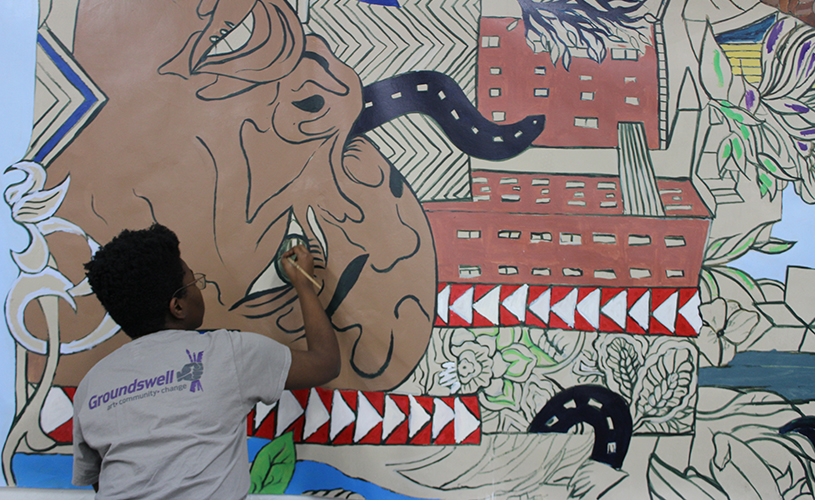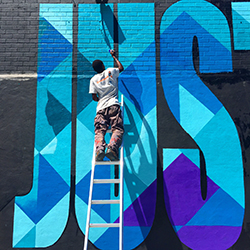It’s to be expected that some residents would object to allocating city funds to creating murals on the external walls of New York City Housing Authority developments when it’s hard to find funds to clear interior walls of persistent, dangerous mold. But Groundswell, a Brooklyn-based community arts nonprofit, regularly proves its value to supporters and detractors alike as it partners with local youth and community stakeholders to turn public walls – in NYCHA developments and elsewhere – into public works of art.
“It always turns out that those who resist in the early stages, the (NYCHA) tenant leaders, become the strongest advocates once they see the final result,” said Nana Ama Bentsi-Enchill, Groundswell’s youth development manager, who joined the organization in 2015. “They will tell that story over and over again, once they grasp the impact of the mural.”
RELATED: How ACS measures its providers' success
Last year, New York City Councilman Ritchie Torres, a Bronx representative who grew up in NYCHA housing, allocated $500,000 to Groundswell. The funds supported the Public Art/Public Housing initiative and produced three youth-led murals in each borough. The funds were from the Mayor’s Action Plan for Neighborhood Safety, a program intended to reduce violence and make neighborhoods safer in and around 15 NYCHA developments that have experienced some of the highest crime rates in the city. Groundswell partnered with Castle Hill Houses in the Bronx, Queensbridge Houses in Queens, Tompkins Houses in Brooklyn, Stapleton Houses in Staten Island and St. Nicholas Houses in Manhattan.
“The Queensbridge project revealed how powerful art can be,” Bentsi-Enchill said. “The neighborhood was full of unengaged youth who were just idling. Once they plugged into the project, they took ownership of it and their commitment followed.”

Since 1996, through the medium of murals, Groundswell has matched artists and inner city youth to walls in underserved communities. The art brings messages of social justice to every corner of the city – including Rikers Island, where Groundswell produced 13 works of art with incarcerated youth in the past year alone.
From intergenerational conflict to gay suicide, the Groundswell murals reflect issues pertinent to each community by design. Sites are selected after a neighborhood survey and conversations with tenant groups and then each mural then follows three distinct phases.
“Following site selection, we speak with community leaders to identify a theme that is meaningful to that neighborhood,” Bentsi-Enchill said. “We are committed to community engagement, taking the time to listen to every voice and respectfully communicate.”
That theme is then handed to two artists – a lead and assistant – who work with participants to craft an image. After a master sketch is produced, the community provides feedback and final approval before a brush touches the wall. Teams of participants then work four days a week for six weeks to complete each assignment.
“The neighborhood was full of unengaged youth who were just idling. Once they plugged into the project, they took ownership of it and their commitment followed.” – Ama Bentsi-Enchill, Groundswell’s youth development manager
Operating with a budget of $2.6 million and an administrative staff of 13 people, the organization engaged 851 youth, 526 community members and 39 artists to cover more than 24,000 square feet of walls in 2016.
“Our mission is based on the belief that art is a transformative tool,” said Robyne Walker Murphy, who is completing her first year as Groundswell’s executive director.
Prior to joining Groundswell, Walker Murphy served at the helm of DreamYard Art Center in the Bronx, which received a National Arts and Humanities Youth Program Award from first lady Michelle Obama in 2012. Her background as an art and social justice educator made the transition to Groundswell seamless.
Over time, Groundswell has formed valuable collaborations with different branches of city government and engaged local officials in support of its mission. In addition to Groundswell’s work with the city Department of Correction, the organization has worked with the city Department of Transportation to produce safety banners, and it offers tours of its murals during the year. In October, the organization will honor Torres at its Annual Art Bash.
RELATED: Nonprofits reflect on Trump's first few months
“New York City is full of Groundswell stories,” Walker Murphy said.
In August, Groundswell’s flagship program, The Summer Leadership Institute, was in full swing as 120 talented local youth worked on six murals. “Through our relationship with (the Summer Youth Employment Program), we provide training and stipends to the participating youths who range in age from 14 to 24,” said Walker Murphy.
On Aug. 31, Groundswell will unveil its 500th mural titled, “Flight of Freedom,” about immigration, at Public School 373, a special needs school in Bedford-Stuyvesant, Brooklyn. An after-school neighborhood party is planned to mark the dedication in collaboration with Gensler, a global design firm and corporate sponsor of the event.

Strong partnerships with city agencies and local businesses buttress the organization during times when the future of various funding sources is under threat.
“Smaller organizations like ours have relied on the NEA up to now, but the instability of the current administration means we have to look elsewhere,” Walker Murphy said. She foresees that Groundswell will grow its donor base and corporative giving portfolio.
‘We need to become more nimble and intentional about the length of time we engage with each community. After all, there’s a limit to the number of available walls, and we will have to consider other types of events,” she said. Earlier this year, Groundswell organized a panel discussion with activist Angela Davis about youth incarceration and Rikers Island.
As the organization embarks on its third decade, Walker Murphy is spearheading a team to develop a five-year plan. Groundswell will consider how to leverage existing artwork to reignite involvement. “Whether we celebrate the existing art through an art fest or a block party, we want to invite the community to re-engage,” she said. “We will seek to deepen our work in the existing communities and continue to go where the need is the greatest, always asking ourselves: How can I use this work for positive change? Above all, Groundswell is a social justice organization.”
Groundswell will also be including other public art forms, from banners to performance art to additional types of materials as it continues to engage the city and its residents.
“We are honored that the city understands the power of public art, to which everyone has access either by creating it or enjoying it,” Walker Murphy said. “Our programs nurture problem-solvers. Studies show that art education yields a better outcome for young people who learn to think outside the box as agents of social change.”


